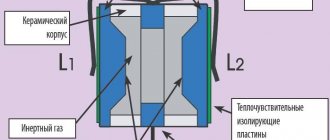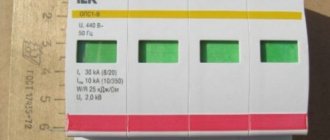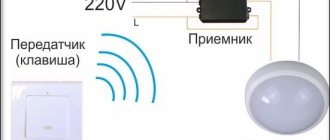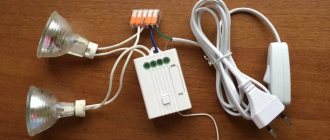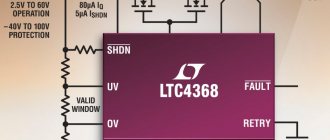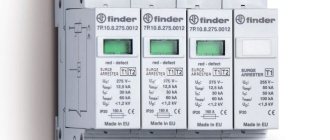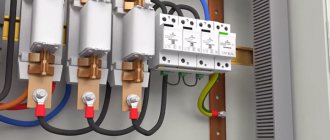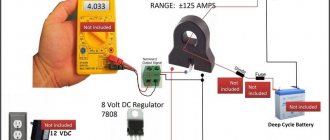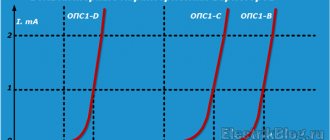Surge protection devices (SPDs) in accordance with GOST R 51992-2011 include devices designed to protect electrical installations and electrical networks from the effects of overvoltages that occur in transient conditions, as well as due to lightning strikes, we will talk about them at StabExpert.ru .
SPDs are designed for connection to alternating current networks with a frequency of 50 – 60 Hz and voltages up to 1000 volts, as well as to direct current circuits with voltages up to 1500 volts.
Device classification
The standard provides for the classification of devices according to the following parameters:
- number of inputs;
- by the method of implementing protective functions;
- by location;
- by installation method;
- by set of protective functions;
- according to the degree of protection of the outer shell;
- by the type of supply current.
This is what devices for protection against lightning and switching overvoltages look like.
Operating principle
The principle of operation of this element is based on a nonlinear resistance characteristic. With standard voltage characteristics, its value is close to zero, so the circuit is not closed through the specified device.
With a sharp increase in voltage, the resistance simultaneously increases. As a result, current flows through the surge arrester, shorting to ground. In this way, the protective function is ensured.
Arresters
The operating principle of arresters is based on the ability of high voltage to pierce an air gap. The breakdown voltage of the gap depends mainly on the size of the air gap.
Air gap
The design of the air discharger is very simple. The size of the air gap between the phase and ground wires is selected in such a way that it is guaranteed not to break through at the operating voltage, but if this value increases multiple times, a breakdown occurs. In this case, an electrical circuit is formed through an arc discharge between the phase and the protective ground. The current pulse flowing into the grounding device relieves overvoltage and protects power circuits from damage.
Valve arrester
An improved model of an air arrester is a valve-type arrester. The valve arrester design includes several components:
- spark gap divided into several air gaps;
- resistor.
The working resistor is a set of disks connected in series, made of vilit or tirite. The properties of these materials are such that the current-voltage characteristic of the operating resistance is nonlinear. This property allows large surge currents to pass through with a small voltage drop across the element itself. Due to the nonlinearity of the characteristic, the arrester is called valve-type. The operation of valve-type arresters occurs almost silently; in addition, such abundant release of gas and flame is not observed as in the case of an air discharger.
Main characteristics
From the design differences described above, differences in characteristics and tests also follow. For arresters, the most important thing is the correct discharge path and ensuring coordinated operation from the protected insulation, while the throughput is so high that its verification comes into the background, like overvoltage limitation. But with surge arresters, the main thing is to ensure thermal balance of the varistors, since when current flows through them, a large amount of energy is released, and also to eliminate overlap along the varistor column. Hence the tests with a rectangular pulse, 8/20 µs pulses, as well as the appearance of such a characteristic as energy dissipation. And of course, the arrester is required to provide overvoltage limitation.
Surge arresters and surge arresters were developed for different purposes, the principles of operation of these devices are different, and therefore the areas of their successful application differ - where the arrester copes well with the task, the surge arrester can “fail”, and the opposite is also true.
SPDs and SPDs are sensitive to overheating. Whereas arresters are resistant to prolonged exposure to elevated temperatures and retain their functionality even if they are heated to temperatures above the operating range. SPDs and SPDs are not resistant to direct lightning strikes. In turn, the arresters are able to withstand the impact of the pulse energy of a direct lightning strike, maintaining their functionality. The only devices that are protected against direct lightning strikes are multi-chamber screen-type arresters RMKE-10-IV-UHL1. They can withstand the load and operate normally by passing lightning current through them.
In RDI and RMC, the main part of the discharge passes outside the device, and therefore they can pass much larger pulse currents (lightning currents) without damage than SPDs. With induced overvoltages, this difference is insignificant, but 6-20 kV overhead lines, although rarely, can be subject to direct lightning strikes, in which case the surge protection devices can be damaged.
Surge arresters - surge suppressors
Surge suppressors are the next step in the evolution of devices that protect against surge voltage surges. This device does not contain air gaps. The main element of the device is a varistor. To be more precise, a set of varistors. To obtain the required performance characteristics, varistors are connected to each other in serial or parallel - serial blocks.
The basis of the varistor is zinc oxide. During the manufacturing process of a varistor, oxides of other metals are also added. StabExpert.ru reminds that as a result, the finished product is a set of p–n junctions connected in parallel and in series. The presence of these semiconductor junctions determines the nonlinear properties of the varistor. The varistors are enclosed in a porcelain or polymer surge suppressor housing. The resistance of arrester varistors is very high in the operating voltage range. When a surge voltage occurs, the resistance of the surge arrester drops sharply, allowing the surge current to flow to ground.
Surge suppressors have some design and functional differences. Classification of surge arresters is carried out according to the following criteria:
- insulation material;
- device designs;
- operating voltage;
- installation location.
Regarding insulation, it has already been said that porcelain or a polymer composition is used. Structurally, surge suppressors can be single-column or multi-column. Surge arresters are produced for each voltage class: 6-10 kilovolts and above. Surge suppressors are installed in closed or open switchgears (closed switchgear, outdoor switchgear).
Design
An arrester is a semiconductor element characterized by a nonlinear resistance value. It is made in the form of vilitic disks, the material of which is zinc oxide with the addition of various impurities.
These disks are equipped with a protective coating, with electrical terminals at the ends. Voltage is supplied to one of the contacts, the second is output to ground.
The surge arrester consists of the following structural elements:
- electrode,
- polyamide body,
- heat shrink tube,
- varistor,
- silicone shell.
Design of surge arresters up to 1000 V
Surge arrester design above 1000 V
Home modular surge protectors for installation in 0.4 kV switchgears
To protect in-house electrical wiring and household appliances from surges of lightning and transient nature, many electrical manufacturers produce compact modular devices that are conveniently located in distribution cabinets.
Such surge protectors are installed on a DIN rail.
Installation
Modular SPDs are connected between the phase and protective ground wires. The connection must be made after the circuit breaker. In this case, when an overvoltage occurs and the device’s varistor opens, the increased varistor current flows through the switch, causing the protection to operate. By turning off, the circuit breaker breaks the connection between the load and the external network, which is a source of increased voltage.
Video on the operation of modular SPDs
Kinds
Due to the wide variety of functions performed, EDs are classified according to the following indicators:
Structure of the symbol of the surge arrester
- The voltage class for which the element is designed. This characteristic is determined by the parameters of the network on which the device is used,
- Protective coating material - the most widely used elements are those using porcelain and polymers,
- Security class – depending on whether the protective unit is used indoors or in an open electrical installation,
Climatic version: U, HL, UHL and others - The number of elements and phases - taking into account the parameters of the equipment or line.
A combination of several devices can be used to provide stepwise protection.
Designation of surge arresters and arresters on the diagram
Material
Depending on the material used for the protective jacket, protection can be achieved using the following types of devices:
- Porcelain is the most common variety. Ceramics are resistant to ultraviolet radiation, so they can be freely used in open installations. Due to their high mechanical strength, such elements can simultaneously serve as a supporting structure. The disadvantages include large weight and fragility, which threatens personnel injury when fragments fly away as a result of the destruction of the element.
- Polymer - rubber, vinyl and other artificial compounds are used as the outer covering material. These devices are resistant to moisture, have lighter weight and good dielectric properties, can withstand significant mechanical stress, but accumulate atmospheric moisture on the surface and react poorly to sunlight.
- Single-column - in the form of a semiconductor element with nonlinear voltage characteristics, with the number of disks, depending on the category of equipment.
- Multi-column - used on high-voltage equipment and consist of several components combined into a single unit. They are distinguished by increased reliability and ability to respond to various load characteristics.
The choice of surge arrester type depends on the parameters of the equipment and its operating conditions.
Application and operating requirements
These protective devices are widely used to protect power lines, various industrial electrical installations, transformer substations, and distribution units. In everyday life, surge arresters are used to protect input distribution panels or high-value equipment.
Surge arresters must be operated in accordance with the requirements of current rules and regulations. The selection of devices is made based on the operating characteristics and characteristics of the equipment.
Maintenance
These limiters do not provide for one-time use and are capable of repeatedly performing their protective function, relieving the voltage on the grounded bus. But during operation, the elements may partially lose their performance characteristics, up to the complete unusability of the devices.
To avoid unscheduled failure of elements, during operation they must undergo scheduled inspection and maintenance, monitoring the following parameters:
- resistance - measured with a megger, at least once every 6 years;
- conduction current - the need to check it arises when the characteristic noted above decreases;
- breakdown voltage and tightness - carried out before putting new devices into operation or in case of factory restoration;
- thermal imaging measurements - according to the manufacturer’s regulations and the maintenance schedule drawn up at the enterprise.
The elements are also inspected for the presence of external defects in the form of burning, accumulation of dust and dirt, and destruction of the insulating coating.
The use of surge arresters allows you to ensure normal operation of electrical equipment, eliminating the risk of damage due to sudden voltage surges. But these limiters must be selected correctly and undergo regulated maintenance in order to preserve them and extend their service life.
